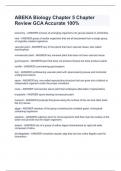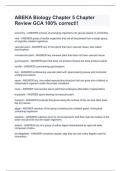Abeka biology chapter 5 - Study guides, Class notes & Summaries
Looking for the best study guides, study notes and summaries about Abeka biology chapter 5? On this page you'll find 10 study documents about Abeka biology chapter 5.
All 10 results
Sort by

-
ABEKA Biology Chapter 5 Chapter Review GCA Latest Update Graded A
- Exam (elaborations) • 6 pages • 2024
- Available in package deal
-
- $9.99
- + learn more
ABEKA Biology Chapter 5 Chapter Review GCA Latest Update Graded A taxonomy process of arranging organisms into groups based on similarities kind group of similar organisms that are all descended from a single group of originally created organisms vascular plant any of the plants that have vascular tissue; also called tracheophyte nonvascular plant any nonseed plant that does not have vascular tissue gymnosperm plant that does not produce flowers but does produce seeds conifer...

-
ABEKA Biology Chapter 5 Chapter Review GCA Latest Update Graded A
- Exam (elaborations) • 6 pages • 2024
-
- $7.99
- + learn more
taxonomy process of arranging organisms into groups based on similarities kind group of similar organisms that are all descended from a single group of originally created organisms vascular plant any of the plants that have vascular tissue; also called tracheophyte nonvascular plant any nonseed plant that does not have vascular tissue gymnosperm plant that does not produce flowers but does produce seeds conifer cone-bearing gymnosperm fern nonflowering vascular plant with spore-bearing le...

-
ABEKA Biology Chapter 5 Chapter Review GCA Latest Update Graded A
- Exam (elaborations) • 6 pages • 2024
-
- $7.99
- + learn more
taxonomy process of arranging organisms into groups based on similarities kind group of similar organisms that are all descended from a single group of originally created organisms vascular plant any of the plants that have vascular tissue; also called tracheophyte nonvascular plant any nonseed plant that does not have vascular tissue gymnosperm plant that does not produce flowers but does produce seeds conifer cone-bearing gymnosperm fern nonflowering vascular plant with spore-bearing le...

-
ABEKA Biology Chapter 5 Chapter Review GCA 100% correct
- Exam (elaborations) • 3 pages • 2024
-
Available in package deal
-
- $9.49
- + learn more
ABEKA Biology Chapter 5 Chapter Review GCA taxonomy - ANSWER process of arranging organisms into groups based on similarities kind - ANSWER group of similar organisms that are all descended from a single group of originally created organisms vascular plant - ANSWER any of the plants that have vascular tissue; also called tracheophyte nonvascular plant - ANSWER any nonseed plant that does not have vascular tissue gymnosperm - ANSWER plant that does not produce flowers but does produce...

-
ABEKA Biology Chapter 5 Chapter Review GCA 100% correct!
- Exam (elaborations) • 3 pages • 2024
- Available in package deal
-
- $11.99
- + learn more
ABEKA Biology Chapter 5 Chapter Review GCA 100% correct!ABEKA Biology Chapter 5 Chapter Review GCA 100% correct!ABEKA Biology Chapter 5 Chapter Review GCA 100% correct!ABEKA Biology Chapter 5 Chapter Review GCA 100% correct!ABEKA Biology Chapter 5 Chapter Review GCA 100% correct!ABEKA Biology Chapter 5 Chapter Review GCA 100% correct!ABEKA Biology Chapter 5 Chapter Review GCA 100% correct!ABEKA Biology Chapter 5 Chapter Review GCA 100% correct!ABEKA Biology Chapter 5 Chapter Review GCA 100% corr...

-
ABEKA Biology Chapter 5 Chapter Review GCA Accurate 100%
- Exam (elaborations) • 3 pages • 2024
-
Available in package deal
-
- $9.99
- + learn more
taxonomy - ANSWER process of arranging organisms into groups based on similarities kind - ANSWER group of similar organisms that are all descended from a single group of originally created organisms vascular plant - ANSWER any of the plants that have vascular tissue; also called tracheophyte nonvascular plant - ANSWER any nonseed plant that does not have vascular tissue gymnosperm - ANSWER plant that does not produce flowers but does produce seeds conifer - ANSWER cone-bearing gym...

-
ABEKA Biology Chapter 5 Chapter Review GCA 100% correct!!
- Exam (elaborations) • 3 pages • 2024
-
Available in package deal
-
- $9.99
- + learn more
taxonomy - ANSWER process of arranging organisms into groups based on similarities kind - ANSWER group of similar organisms that are all descended from a single group of originally created organisms vascular plant - ANSWER any of the plants that have vascular tissue; also called tracheophyte nonvascular plant - ANSWER any nonseed plant that does not have vascular tissue gymnosperm - ANSWER plant that does not produce flowers but does produce seeds conifer - ANSWER cone-bearing gym...

-
Review for Chapter 18 Abeka Biology Rated A+
- Exam (elaborations) • 6 pages • 2024
- Available in package deal
-
- $9.99
- + learn more
Review for Chapter 18 Abeka Biology Rated A+ poikilotherm animals whose body temperature fluctuates during the day ovoviviparous to bring forth alive from eggs lateral undulation A type of snake movement in which it bends into a series of curves as it keeps its body flat on the ground rectilinear movement A type of snake movement in which it alternately stretches and shortens segments of its body in order to creep forward in a straight line concertina movement a type of snake...

-
Abeka Biology: God's Living Creation: Section Review 21.6 Already Passed
- Exam (elaborations) • 4 pages • 2024
- Available in package deal
-
- $8.99
- + learn more
Abeka Biology: God's Living Creation: Section Review 21.6 Already Passed 1. What are the four main groups of protozoa? On what major characteristics is this classification based? The four main groups of protozoas are: Flagellates, sarcodines, ciliates, sporozoan. On methods of locomotion. 2. In what way(s) is the reproduction of amoebas different from that of paramecia? The amoeba exhibits reproduction by binary fission, paramecia exhibits sexual reproduction by a process called conj...
ABEKA BIOLOGABEKA BIOLOGY PACKAGE DEAL!Y PACKAGE DEAL!ABEKA BIOLOGABEKA BIOLOGY PACKAGE DEAL!Y PACKAGE DEAL!ABEKA BIABEKA BIOLOGY PACKAGE DEAL!OLOGY PACKAGE DEAL!ABEKA BIOLOGY PACKAGE DEAL!

How did he do that? By selling his study resources on Stuvia. Try it yourself! Discover all about earning on Stuvia


